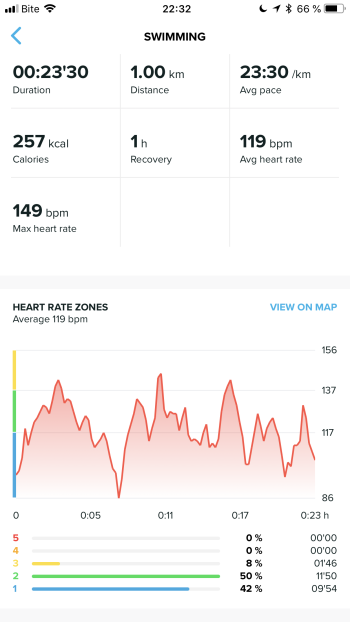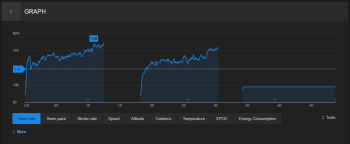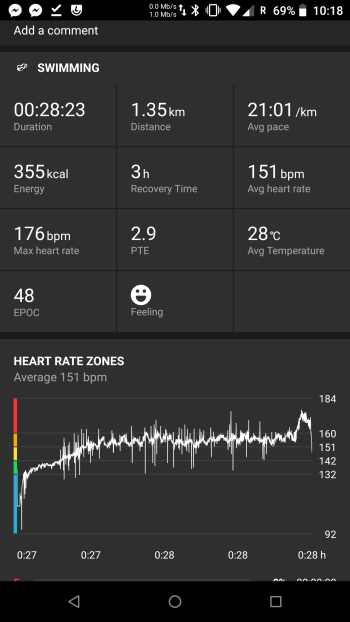Smart sensor
-
Maybe it helps:
When using the sensor in the water please:
- Start the excersise when the sensor is connected and shows HR working. If not done like this it will use OHR and will not send the command to the HR sensor to record.
- When ending the excersise do not do in water. Get out or make sure sensor + watch are out of the water and the watch has HR signal. For example when done, press pause, get out of the water, switch the screens on the pause to see the live HR. Then press end. The watch will pull the recorded HR from the sensor (also does it while paused).
I hope this helps
-
@Ze-Stuart this is your swim workout screenshot

-
@SlaSh I know, I recognise the bad data…
@Dimitrios-Kanellopoulos superb, basic steps.
-
@Ze-Stuart every your swim looks like this
 so ohrm even works better than your chest strap
so ohrm even works better than your chest strap 
-
@SlaSh only in the app… even when I threaten to bite it. (I think Mr. @Dimitrios-Kanellopoulos said it was fixed in an upcoming release, actually, and the whole thing is an interesting insight into how the two discrete data channels are bonded into one.)
-
@Ze-Stuart it is strange situation as swim with ohrm displayed fine…
-
-
@Dimitrios-Kanellopoulos quite strange situation how same application on different OS is acting…But how come HR with OHRM is shown fine even on iOS app?

-
@slash that is a good question I can answer.
Some belts and OHRs have the ability to send IBI data to the watch.
IBI stands for interbeat interval, known as R-R as well.
This is the time, usually in milliseconds, between to beats.IBI is the mother of HR. All belts/etc that report HR ONLY so some processing on an IBI set buffer.
Good to know:
HR is actually a “stupid” value as it lets you see the value of Beats Per Minute but you update it every 1s. Now add to that that 1s can contain even one beat (60BPM) the more low you drop the more hard it gets as of time needed to calculate. If for example the HR is < 60 BPM, lets say 30bpm imagine that every 2 seconds you get a beat. Anyways you can take a look in this section to know more if youlikeTo cut a long story short someone has to process the IBI and derive an HR for the user.
Since IBI is stored on the watch and not HR if not from OHR, then the app, fails to process that. Why I do not know.I have implemented the IBI data in my app(quantify-self not Suunto ) and feel free to ask any questions about. Just for the record, I had to study and experiment for 2 weeks longs to be able to give a correct result.
-
@SlaSh said in Smart sensor:
But how come HR with OHRM is shown fine even on iOS app?
Here’s what I think is happening with my swim: I record using a chest strap, which means that the two data streams - swim data from watch, and HR data from strap - have to be incorporated into one. The summary on the watch is always wrong, and mirrors what we see in the app, which makes me think the app pulls the watch’s summary. Movescount, on the other hand, shows correct data: I think because it either re-analyses the data from the watch, or, because there are two discrete files (HR and swim data) that it recombines and aligns.
When you record HR with the HRM in the watch, the data is recorded live, hence the data in the app is correct. Unless, of course, I misunderstood and the OHRM you’re talking about is an external one, and that would explain why @Dimitrios-Kanellopoulos has his comment about HRV (which he’s right, is the interesting, juicy, high-resolution HR data we truly want).
I have a ticket with Suunto about incorrect watch summaries, which they’ve sent off to Finland.
-
OHRM should stand for Optical Heart Rate Monitoring, so the watch
And it should be this case as the other sensor involved is the belt one … as far as I understood -
@Ze-Stuart if you have a belt paired ohr should not work. Can you double check that ?
-
@Dimitrios-Kanellopoulos doesnt work I can confirm for baro.
-
@SlaSh and what happens if the belt goes out of reach ?/
-
@Dimitrios-Kanellopoulos HR is not tracked
 same story with if belt battery is depleted ohrm is not engaged and you are left without hr tracking until you stop workout.
same story with if belt battery is depleted ohrm is not engaged and you are left without hr tracking until you stop workout. -
@SlaSh yeah that is intentional since you are using the belt. I would never prefer the opposite.
There were a lot of cases in the past that people complained about this behavior of switching to ohr.
If you select the belt it should be the belt. You can leave the watch at the gym locker and go train without making it a mess.
-
@Dimitrios-Kanellopoulos Why not to leave option for user to use or not to use ohrm if signal with belt is lost?
-
@SlaSh that is what it should have been like. But it’s strange it isn’t.
-
@Ze-Stuart I have already done all the hints about the HR sensor, I bought a new sensor and it worked a week or two properly and then everything went bad. I’m using a Decathlon sensor for 30 USD and everything works great, just swimming is a problem. I bought a Wahoo sensor and check how it works. Suunto, I’ll get rid of the sensor.
-
@Brad_Olwin
Any new info about the acknowledged issue?
I just bough a new smart sensor as I have started doing a lot of open water swimming. But I am getting only partial data from the smart sensor/SSU…Paused ewach stint in OWS, last one didnt get recorded…

